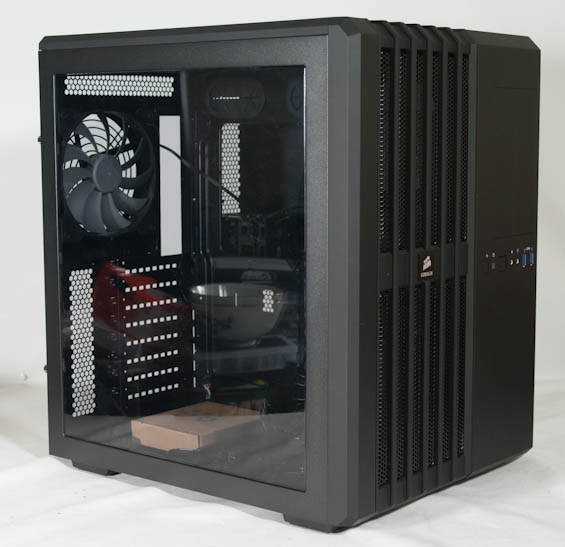The Neophyte's Custom Liquid Cooling Guide: How To, Why To, What To Expect
by Dustin Sklavos on September 30, 2013 12:01 AM ESTPlextor M5P Xtreme 256GB SSD

For this build we needed a fast SSD with enough capacity to hold our entire benchmarking suite, and Plextor was able to accommodate us. The M5P Xtreme we were sent is a 256GB SATA 6Gbps solid state drive with a 7mm height (as is becoming the norm), rated for sequential speeds of up to 540MB/sec reads and 460MB/sec writes, and a random read/write rating of 100,000/86,000 IOPS. It employs an enterprise class Monet 88SS9187 controller, and definitely met our needs during testing.
Our thanks to Plextor for this solid state drive.
Corsair AX1200i Power Supply

Truth be told, Corsair had provided me this power supply some time ago for testing with their Corsair Link software, and it's proven to be absolutely worthy for this build. The AX1200i is a fully modular, 200mm power supply rated for up to 1200 watts and 80 Plus Platinum certified, and it boasts one single, beefy 12V rail. When this unit is running at 30% or less load, the fan actually stops completely, but even under duress I found its fan noise to be negligible at worst. What makes it ideal, of course, is that it can easily supply the required current for two GTX 780s and an i7-4770K with plenty of overclocking headroom. The Corsair Link support is an added perk.
Our thanks to Corsair for this power supply.
Corsair Carbide Air 540 Enclosure

When it came to choosing a case, I really had my pick of the litter. You can plead favoritism, but honestly I've found Corsair's mid-to-high end offerings to be the most desirable for watercooling. Initially I'd planned on using the Micro-ATX Obsidian 350D, but then the Carbide Air 540 launched and I elected to go full ATX. In addition to just being a very interesting looking case, the Carbide Air 540 is perfect because it lets me test an air cooled system for comparison without having to use a case with middling air cooling performance. The case also supports a 360mm radiator in the front and a 240mm radiator in the top, giving a very healthy amount of cooling capacity when the switch to watercooling is made.
That, and like I said, it's just really neat.
Our thanks to Corsair for this enclosure.
Noctua NH-U14S Air Cooler

In order to prove the hypothesis we're entering into this review with, we need a control. Noctua's NH-U14S air cooler serves as that control; this cooler is incredibly quiet but also very efficient. This and its smaller sibling, the NH-U12S, are two of my favorite air coolers. Though they don't come cheap, they're awfully close to as good as you'll get on air if noise matters to you. The NH-U14S did not disappoint.
Our thanks to Noctua for this cooler.


_thumb.jpg)
_thumb.jpg)
_thumb.jpg)
_thumb.jpg)
_thumb.jpg)
_thumb.jpg)








106 Comments
View All Comments
Sadrak85 - Monday, September 30, 2013 - link
And one more thing is the addition of onboard voltage regulation, which is a lossy process almost by definition. Meaning, even with the better TIM, I seriously have my doubts that the thermals could hit the level of IVB or SB. Unless Intel somehow has some magic way of using the voltage and amperage they're scrubbing off.*small note, a good motherboard input, in terms of electricity, would pass through the filters pretty cleanly, but because Intel sets the specifications for the input, I have my doubts that they require such a thing, since the feature they added to their chip was to save money for the motherboard vendor.
leafonwind - Monday, September 30, 2013 - link
The thermal interface material is minor compared to the interface distance. Thermal resistance is L/kA. Going from a millimeter of thermal paste to an 10 micron gap (typical of paste when applied correctly) will give a 50x improvement. The difference in k between a good thermal paste and a bad thermal paste is typically a 5x difference unless you get into exotic materials like cadmium. http://forums.anandtech.com/showthread.php?t=22618...gandergray - Tuesday, October 1, 2013 - link
To bolster Von's point, see the work performed by Idontcare: http://forums.anandtech.com/showpost.php?p=3405318... .merikafyeah - Monday, September 30, 2013 - link
Super tiny correction: While it is true that liquids draw away heat much better than air, one must be cautious not to mistake water as a good CONDUCTOR of heat, aka something that "transfers" heat very well. Water is in fact an INSULATOR of heat, aka something that "absorbs" heat very well.merikafyeah - Monday, September 30, 2013 - link
Note wording on first page, third paragraph.ShieTar - Monday, September 30, 2013 - link
Correct, but to be precise, neither air nor water will conduct heat quickly enough for PC cooling purposes, both are only used to absorb the heat before being transported away from the heat source.Which makes you wonder how a closed-loop, compressed air cooling system would fare against a water-cooling system. Heat capacity might still be lower for air than for water, even at increased pressures, but I assume that you can produce higher flow rates for a compressed gas than for a liquid. And you could use the required compressor in order to:
1) Reduce the air temperature below room temperature before sending it to the heat sources.
2) Increase radiator temperature over the CPU/GPU temperatures, thus achieving the same heat transfer with lower air flow rates through the radiator. Though temperatures above 100°C may be unsafe in a consumer device for several reasons.
Does anybody know if such a system has been considered and tested anywhere?
Death666Angel - Monday, September 30, 2013 - link
Considered? Probably. Used? Not to my knowledge. If you have a compressor it makes more sense to cool the water used in the loop to just above freezing or even below freezing with the right additives. Of course, if you cool it that much, you have to worry about condensation, so most people I read about who use compressor cooling for their liquid (instead of large radiators) keep the water around room temperature and have the cooler in another room, to not be bothered by the noise.The stuff that is used to conduct heat away from the components inside the PC is the metal heatsink. In the case of pure air cooling you then push air through the metal heatsink fins. Because of the delta T you have the air warming up, the metal cooling and being able to absorb heat from the CPU/GPU etc. again. In case of water cooling, you have the water running through the heatsink (usually some very fine canals inside that increase surface and flow rate) which absorbs the heat from the heatsink and gets transported to (large) radiators where air is again pushed/pulled through the radiator fins in order to cool it.
Sadrak85 - Monday, September 30, 2013 - link
Used all the time; Nitrogen is the most common component of air; it is compressed so much as to become a liquid. Then, thanks to the Carnot cycle, cooling the liquid to room temperature results in it boiling and becoming ultra-cold air, which cools a processor.A similar thing happens with your refrigerator.
These coolers, however, require massive power to get them to that level, so they're only really useful for very niche-applications, but the equipment isn't really that hard to find. An evaporator will cost you something like $200 to $300, and then the Nitrogen.
Now, if you're talking about keeping the air gaseous, then what you'll find is it just isn't possible. Cooling it very much with pressure on it will result in it condensing to liquid. If you just compress it, without the cooling, you'll heat it up, of course, which is how your diesel engine works.
ShieTar - Monday, September 30, 2013 - link
Fair enough. I am fully aware of the cooling concept via liquid nitrogen boiling itself, but I was considering a much simpler concept. Maybe I should describe it in a bit more detail.Imagine a closed air (or just nitrogen) system where the air pressure is about 3 bar within a radiator and about 2 bar when it circulates within the cooling blocks. You can have temperatures around 200K at 2 bar without liquifying, and not that much higher at 3 bar.
So you offer your GPU/CPU coolers 2bars of air at 200K, maybe heat it to 220K, compress it to 3bar/330K, cool it back down to 300K (close to room temperature), decompress back to 2bar/200K.
What needs a little more math is, just how much volume of gas do I need for this to transport 600W or so of power by this concept. And how much additional energy do I waste on the compression process. And probably, just how horribly noisy will this setup get with 2bars of air at high velocities getting pressed through the cooling blocks at high velocities.
Yeah, the more I think about it, the worse the whole concept sounds. Nevermind it.
UltraWide - Monday, September 30, 2013 - link
Excellent article, I enjoyed reading this journey into water cooling. Keep up the great work!